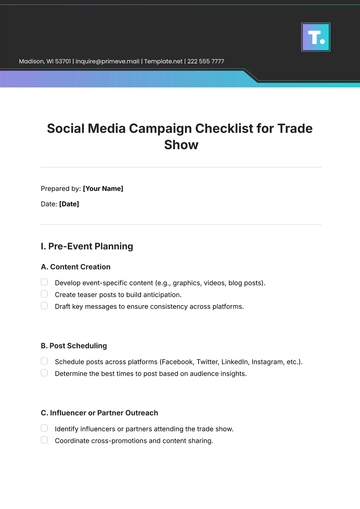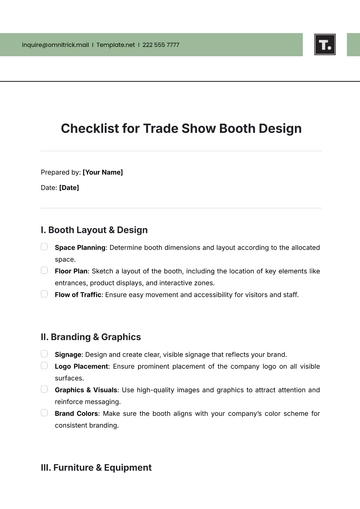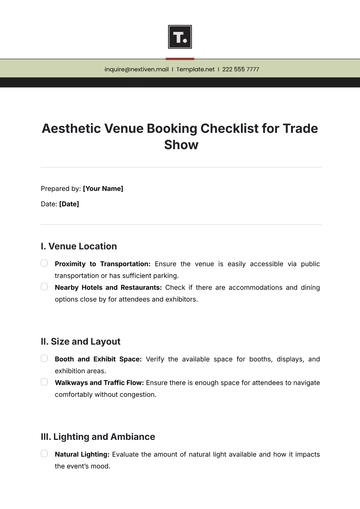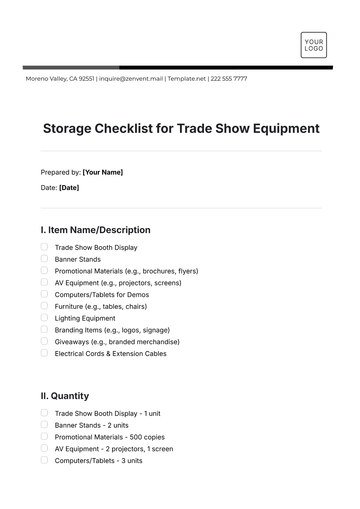Free Social Media Campaign Checklist for Trade Show

Prepared by: [Your Name]
Date: [Date]
I. Pre-Event Planning
A. Content Creation
Develop event-specific content (e.g., graphics, videos, blog posts).
Create teaser posts to build anticipation.
Draft key messages to ensure consistency across platforms.
B. Post Scheduling
Schedule posts across platforms (Facebook, Twitter, LinkedIn, Instagram, etc.).
Determine the best times to post based on audience insights.
C. Influencer or Partner Outreach
Identify influencers or partners attending the trade show.
Coordinate cross-promotions and content sharing.
D. Promotional Hashtags
Create and promote event-specific hashtags (e.g., #TradeShow2024).
Encourage attendees and exhibitors to use hashtags.
E. Event Teasers
Share behind-the-scenes content leading up to the event.
Highlight key speakers, exhibitors, and activities.
II. Event Day Strategy
A. Real-Time Posting
Share live updates, including photos and videos of the event.
Post highlights such as keynote speakers, product launches, and special announcements.
B. Live Coverage
Stream or post live videos from the trade show floor.
Conduct live Q&A sessions or interviews with attendees and exhibitors.
C. Attendee Interaction
Respond to questions, comments, and mentions.
Engage with attendees by asking for polls or starting conversations.
D. Visual Content Sharing
Share high-quality photos and videos of booths, products, and networking events.
Use Instagram Stories or Twitter Fleets for quick updates.
III. Post-Event Follow-Up
A. Thank-You Posts
Thank attendees, speakers, and sponsors for their participation.
Acknowledge the success of the event and share future event dates.
B. Recaps
Post-event highlights, key takeaways, and memorable moments.
Share any post-event content, such as presentations or white papers.
C. Post-Event Engagement
Continue engaging with attendees by asking for feedback.
Encourage attendees to share their experiences and tag the event.
IV. Metrics and Analytics
A. KPIs to Track
Engagement rate (likes, shares, comments).
Growth in followers across social media platforms.
Hashtag performance (reach, impressions, and usage).
B. Engagement Levels
Monitor which posts received the most interaction.
Analyze audience demographics and behavior during the event.
C. Hashtag Performance
Measure the effectiveness of promotional hashtags.
Track how often event hashtags were used by attendees and influencers.
D. Content Reach
Review how far content has traveled across social media platforms.
Track referral traffic from social media to the event website or landing pages.
V. Team and Role Assignments
A. Content Creation
Assign content creation responsibilities to team members (e.g., graphics, blog posts, video).
B. Social Media Monitoring
Assign social media monitoring to a team member for real-time engagement and response.
C. Reporting
Designate a team member to track and report on social media performance during and after the event.
- 100% Customizable, free editor
- Access 1 Million+ Templates, photo’s & graphics
- Download or share as a template
- Click and replace photos, graphics, text, backgrounds
- Resize, crop, AI write & more
- Access advanced editor
Maximize your online presence with the Social Media Campaign Checklist for Trade Show Template on Template.net. This editable and customizable template ensures that every social media strategy for your event is covered, from content creation to post-event engagement. Editable in our Ai Editor Tool, you can tailor the checklist to suit your campaign needs, making it easier to track progress and boost engagement leading up to and during the trade show.
You may also like
- Cleaning Checklist
- Daily Checklist
- Travel Checklist
- Self Care Checklist
- Risk Assessment Checklist
- Onboarding Checklist
- Quality Checklist
- Compliance Checklist
- Audit Checklist
- Registry Checklist
- HR Checklist
- Restaurant Checklist
- Checklist Layout
- Creative Checklist
- Sales Checklist
- Construction Checklist
- Task Checklist
- Professional Checklist
- Hotel Checklist
- Employee Checklist
- Moving Checklist
- Marketing Checklist
- Accounting Checklist
- Camping Checklist
- Packing Checklist
- Real Estate Checklist
- Cleaning Checklist Service
- New Employee Checklist
- Food Checklist
- Home Inspection Checklist
- Advertising Checklist
- Event Checklist
- SEO Checklist
- Assessment Checklist
- Inspection Checklist
- Baby Registry Checklist
- Induction Checklist
- Employee Training Checklist
- Medical Checklist
- Safety Checklist
- Site Checklist
- Job Checklist
- Service Checklist
- Nanny Checklist
- Building Checklist
- Work Checklist
- Office Checklist
- Training Checklist
- Website Checklist
- IT and Software Checklist
- Performance Checklist
- Project Checklist
- Startup Checklist
- Education Checklist
- Home Checklist
- School Checklist
- Maintenance Checklist
- Planning Checklist
- Manager Checklist
- Wedding Checklist
- Vehicle Checklist
- Travel Agency Checklist
- Vehicle Inspection Checklist
- Interior Design Checklist
- Backpacking Checklist
- Business Checklist
- Legal Checklist
- Nursing Home Checklist
- Weekly Checklist
- Recruitment Checklist
- Salon Checklist
- Baby Checklist
- Equipment Checklist
- Trade Show Checklist
- Party Checklist
- Hospital Bag Checklist
- Evaluation Checklist
- Agency Checklist
- First Apartment Checklist
- Hiring Checklist
- Opening Checklist
- Small Business Checklist
- Rental Checklist
- College Dorm Checklist
- New Puppy Checklist
- University Checklist
- Building Maintenance Checklist
- Work From Home Checklist
- Student Checklist
- Application Checklist





























